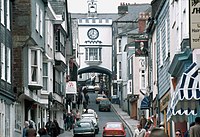Transition town
The transition model can be applied to different types of places where people live, such as villages, regions, islands and towns.[9] This looked at across-the-board creative adaptations in the realms of energy production, health, education, economy and agriculture as a "road map" to a sustainable future for the town.They then presented their ideas to Kinsale Town Council, to which the councilors decided to adopt the plan and work towards energy independence.[11] In early 2007,[12] the Transition Network UK charity was co-founded by permaculture educator Rob Hopkins, Peter Lipman and Ben Brangwyn.[24] Some of the material has been translated and adapted to other languages/cultures, including Portuguese, Danish, German, Dutch, Spanish, French, Hungarian, Italian, Japanese and Irish.[25] TN has run seven conferences: Nailsworth (2007), Royal Agriculture College, Cirencester (2008), Battersea Arts Centre (2009), Dame Hannah's at Seale Hayne (2010), Hope University, Liverpool (2011), Battersea Arts Centre (2012)[26] and Dame Hannah's at Seale Hayne (2015).[8][33] The Transition Network's (TN) stated aim is to promote awareness of sustainable living and building local ecological resilience.[40] The Transition Network proposes an alternative from business as usual, or from 'shocked/doomladen' reactions to peak oil and an end to unlimited economic growth.[43][44] The psychological work reframed as inner [45] continued through to 2024 Transition towns aim to reduce dependency on fossil fuels, and one way they do this is by developing a community Energy descent action plan (EDAP).[51] Further, it saw the creation of local complementary currencies as reinforcing moves toward sustainable low carbon economies as well as being socially beneficial.They document the progress of various initiatives: In 2008, the Trapese Collective published a critique called The Rocky Road to a Real Transition to which Hopkins replied.
grassrootcommunity projectspeak oilclimate destructionTotnesUnited KingdompermacultureRob HopkinsKinsaleEnglandSilver Donald CameronIrelandCanadaAustraliaNew ZealandUnited StatesPortobelloPenwithBrixtonBill MollisonDavid HolmgrenDavid FlemingautonomynetworkingNing social networking platformsustainable livingecological resilienceSustainable transportfood milescommunity gardensindustrial symbiosisEnergy descentFranceassociation négaWattList of community currencies in the United Kingdom2008 global financial crisisfiscal localismcomplementary currenciesTotnes poundLewes poundStroud poundBBC Radio 4The ArchersShaun ChamberlinEnvironmental PoliticsCarfree cityCircles of SustainabilityClimate changeCommunity currenciesDegrowthDemographic transitionElectric vehicleFairtrade TownFood swapGreat TransitionPetitionsRenewable electricitySolidarity economySustainable cityTransition management (governance)Transition economyUrban vitalityWinning the Oil EndgameGreen DrinksOpen Source EcologyNew Economics FoundationNew Economy CoalitionTheGuardian.comThe Nelson MailYouTubeBBC NewsThe Hollywood ReporterCauses of climate changeEffects of climate changeClimate change mitigationClimate change adaptationCausesClimate systemGreenhouse effectCarbon dioxide in Earth's atmosphereScientific consensus on climate changeDeforestationFossil fuelGreenhouse gasesGreenhouse gas emissionsCarbon accountingCarbon footprintCarbon leakagefrom agriculturefrom wetlandsWorld energy supply and consumptionHistory of climate change policy and politicsHistory of climate change scienceSvante ArrheniusJames HansenCharles David KeelingUnited Nations Climate Change conferencesEffects and issuesAbrupt climate changeAnoxic eventArctic methane emissionsArctic sea ice declineAtlantic meridional overturning circulationDroughtExtreme weatherCoastal floodingHeat waveMarineUrban heat islandOceansacidificationdeoxygenationheat contentsea surface temperaturestratificationtemperatureOzone depletionRetreat of glaciers since 1850Sea level riseSeason creepTipping points in the climate systemTropical cyclonesWater cycleWildfiresBiomesMass mortality event
